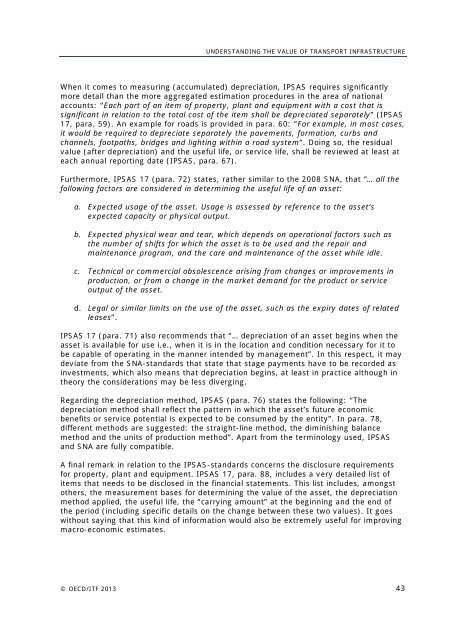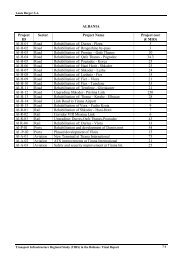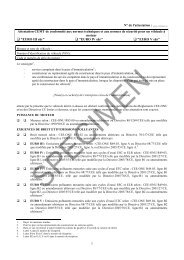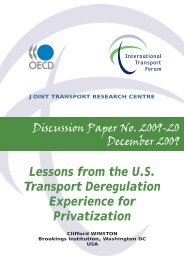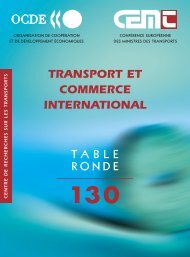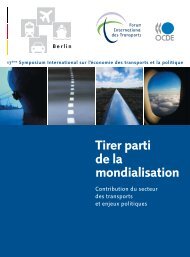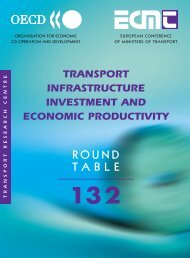Understanding the Value of Transport Infrastructure ...
Understanding the Value of Transport Infrastructure ...
Understanding the Value of Transport Infrastructure ...
Create successful ePaper yourself
Turn your PDF publications into a flip-book with our unique Google optimized e-Paper software.
UNDERSTANDING THE VALUE OF TRANSPORT INFRASTRUCTURE<br />
When it comes to measuring (accumulated) depreciation, IPSAS requires significantly<br />
more detail than <strong>the</strong> more aggregated estimation procedures in <strong>the</strong> area <strong>of</strong> national<br />
accounts: “Each part <strong>of</strong> an item <strong>of</strong> property, plant and equipment with a cost that is<br />
significant in relation to <strong>the</strong> total cost <strong>of</strong> <strong>the</strong> item shall be depreciated separately” (IPSAS<br />
17, para. 59). An example for roads is provided in para. 60: “For example, in most cases,<br />
it would be required to depreciate separately <strong>the</strong> pavements, formation, curbs and<br />
channels, footpaths, bridges and lighting within a road system”. Doing so, <strong>the</strong> residual<br />
value (after depreciation) and <strong>the</strong> useful life, or service life, shall be reviewed at least at<br />
each annual reporting date (IPSAS, para. 67).<br />
Fur<strong>the</strong>rmore, IPSAS 17 (para. 72) states, ra<strong>the</strong>r similar to <strong>the</strong> 2008 SNA, that “… all <strong>the</strong><br />
following factors are considered in determining <strong>the</strong> useful life <strong>of</strong> an asset:<br />
a. Expected usage <strong>of</strong> <strong>the</strong> asset. Usage is assessed by reference to <strong>the</strong> asset’s<br />
expected capacity or physical output.<br />
b. Expected physical wear and tear, which depends on operational factors such as<br />
<strong>the</strong> number <strong>of</strong> shifts for which <strong>the</strong> asset is to be used and <strong>the</strong> repair and<br />
maintenance program, and <strong>the</strong> care and maintenance <strong>of</strong> <strong>the</strong> asset while idle.<br />
c. Technical or commercial obsolescence arising from changes or improvements in<br />
production, or from a change in <strong>the</strong> market demand for <strong>the</strong> product or service<br />
output <strong>of</strong> <strong>the</strong> asset.<br />
d. Legal or similar limits on <strong>the</strong> use <strong>of</strong> <strong>the</strong> asset, such as <strong>the</strong> expiry dates <strong>of</strong> related<br />
leases”.<br />
IPSAS 17 (para. 71) also recommends that “… depreciation <strong>of</strong> an asset begins when <strong>the</strong><br />
asset is available for use i.e., when it is in <strong>the</strong> location and condition necessary for it to<br />
be capable <strong>of</strong> operating in <strong>the</strong> manner intended by management”. In this respect, it may<br />
deviate from <strong>the</strong> SNA-standards that state that stage payments have to be recorded as<br />
investments, which also means that depreciation begins, at least in practice although in<br />
<strong>the</strong>ory <strong>the</strong> considerations may be less diverging.<br />
Regarding <strong>the</strong> depreciation method, IPSAS (para. 76) states <strong>the</strong> following: “The<br />
depreciation method shall reflect <strong>the</strong> pattern in which <strong>the</strong> asset’s future economic<br />
benefits or service potential is expected to be consumed by <strong>the</strong> entity”. In para. 78,<br />
different methods are suggested: <strong>the</strong> straight-line method, <strong>the</strong> diminishing balance<br />
method and <strong>the</strong> units <strong>of</strong> production method”. Apart from <strong>the</strong> terminology used, IPSAS<br />
and SNA are fully compatible.<br />
A final remark in relation to <strong>the</strong> IPSAS-standards concerns <strong>the</strong> disclosure requirements<br />
for property, plant and equipment. IPSAS 17, para. 88, includes a very detailed list <strong>of</strong><br />
items that needs to be disclosed in <strong>the</strong> financial statements. This list includes, amongst<br />
o<strong>the</strong>rs, <strong>the</strong> measurement bases for determining <strong>the</strong> value <strong>of</strong> <strong>the</strong> asset, <strong>the</strong> depreciation<br />
method applied, <strong>the</strong> useful life, <strong>the</strong> “carrying amount” at <strong>the</strong> beginning and <strong>the</strong> end <strong>of</strong><br />
<strong>the</strong> period (including specific details on <strong>the</strong> change between <strong>the</strong>se two values). It goes<br />
without saying that this kind <strong>of</strong> information would also be extremely useful for improving<br />
macro-economic estimates.<br />
© OECD/ITF 2013 43


